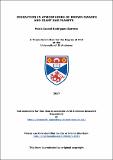Ionization in atmospheres of brown dwarfs and giant gas planets
Abstract
Recent observations of ultra-cool objects suggest that the gas in their uppermost atmospheres is heated, ionised and magnetised to levels that radio and X-ray emission is possible. The aim
of this work is to identify which low mass objects are most susceptible to plasma and magnetic
processes by the effect of thermal ionisation and Lyman continuum photoionisation from the
irradiation of external sources in different environments. I focus my work on very low mass,
ultra-cool objects (late M-dwarfs, brown dwarfs and giant gas planets: T[sub]eff = 1000 . . . 3000 K)
to analyse the electrostatic and magnetic character of these atmosphere. This work has been
carried out in two distinct parts:
a) A reference study to identify which ultra-cool objects are most susceptible to plasma and
magnetic processes considering the thermal ionisation as the only mechanism to ionise
the atmospheric gas. This presents a theoretical framework using a set of fundamental
parameters to analyse the ionisation and magnetic coupling state of objects with
ultra-cool atmospheres. The DRIFT-PHOENIX model atmosphere simulations are used to
determine the local gas properties T[sub]gas [K], p[sub]gas [bar], pₑ [bar] of the atmospheres
structures from the global parameters T[sub]eff [K], log(g) [cm s⁻²] and [M/H]. Electrostatics
interactions dominance over electron-neutral interactions increases as T[sub]eff increases:
throughout the M-dwarf atmospheres, almost for the whole brown dwarf atmospheres
and only giant gas planets with T[sub]eff =1200 K, log(g)=3.0, [M/H]=+0.3 fulfil that criterion
at the most deeper atmosphere. A magnetised gas is found for M-dwarfs, brown
dwarfs and giant gas planet atmospheres even for those with a small degree of ionisation
except to the most deeper atmospheric regions. Hence, the upper atmosphere of
all of studied objects can be magnetically coupled. A large fraction of the atmospheric
volume of M-dwarfs and of early spectral subtypes of brown dwarfs is found to occur
plasma processes and magnetised gas, and are therefore the best candidates to emit in
Hα and radio wavelengths.
b) An analysis of how the Lyman continuum external irradiation effect the plasma and magnetic
state of an ultra-cool atmospheres in additional thermal ionisation. The Monte
Carlo radiative transfer code simulations provide the atmospheric ionisation structure
due to photoionisation. Three different cases are studied to see the effect of the Lyman
continuum irradiation given by an external source: free-floating ultra-cool objects
irradiated by Lyman continuum photons from the interstellar medium (dominated by
Galactic O and B stars), brown dwarfs in star forming regions irradiated by a nearby
(few parsecs) O star and binary systems where a brown dwarf atmosphere is photoionised
by a companion white dwarf. The effect of Lyman continuum irradiation from
external sources greatly increases the level of ionisation in the uppermost atmospheric
regions. Brown dwarfs in star forming regions and brown dwarfs in binary systems with
a companion white dwarf have upper atmospheres that are close to being fully ionised.
Adopting temperatures typical for a chromosphere or a corona, the resulting free-free
X-ray luminosities are found to be comparable with those observed from brown dwarfs
in star forming regions. The results of this study show that it is not unreasonable to
expect powerful energy emissions from brown dwarf atmospheres.
The conclusions of this study are that the thermal ionisation allows the establishment of a magnetised plasma in brown dwarf atmospheres as in particular the rarefied upper parts of the atmospheres despite having low degrees of thermal gas ionisation and that the Lyman continuum photoionisation allows to argue for a chromosphere/corona on brown dwarfs and for X-ray emissions from ultra-cool objects. However, other mechanisms, like Alfvén wave heating, are needed to occur which then lead to rise the local gas temperature in the chromosphere/corona on brown dwarfs.
Type
Thesis, PhD Doctor of Philosophy
Collections
Items in the St Andrews Research Repository are protected by copyright, with all rights reserved, unless otherwise indicated.

